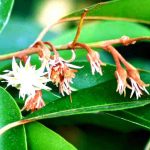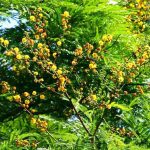TREE LIFE
June 1986
MASHONALAND CALENDAR
Saturday June 7th : Botanic Garden Walk. Meet at the Car Park at 1045 hours for 1100 hours.
Sunday June 15th : Ivordale Farm, Enterprise Area. Trevor Cox, manager of Mr. P. C. Pascoe’s Ivordale Farm, has kindly agreed to us re-visiting the farm. Some may remember the last successful outing in August 1983. The recce revealed very different kopjes this time with large Croton gratissimus, Ficus glumosa and F.ingens. We also saw the birth of a calf, although Trevor has not diarized an action replay for the 15th. Please note, that as with so many of our trips, outside Harare there is a risk of malaria, we advise the use of Deltaprim tablets before and for three to 4 weeks afterwards. The bus will leave Monomatapa Car Park at 0830 hours. The fare, which includes bus and security guard is $8.00.
MATABELELAND CALENDAR
Thankfully I am not reporting our outings, but I just want to say how delighted we were to hear that some of you Harare Folk were going to come here this May holiday, and how much we enjoyed meeting so many of you in our Area. Indeed, it was a great pleasure.
-C.Sykes
THE MATOPOS : 1ST – 4TH MAY 1986
Thursday May 1st – Maleme. A more perfect setting for a Tree Society outing you could not ask for. Our comfortable lodges were surrounded by a wealth of trees set off by the tumble of granite rocks, Croton gratissmus is profuse flower, the Lavender tree in beady buds, Apodytes dimidiata in polished, pink petioled leaf, Commiphora marlothii in tatters, Lannea discolor in the nude, a giant fig in agony, slowly crunching an obdurate granite block; a duiker berry in translucent fruit.
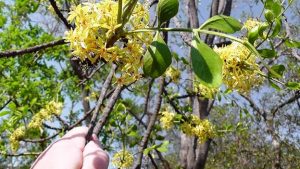
Ptaeroxylon obliquum. Photo: Bryan Orford. Source: Flora of Zimbabwe
In all this profusion it was easy to miss the fact the Olea were as big as you would ever see them, that a large Entandophragma was heavy with fruit and the Kirkia acuminata spreading itself over the rocks was certainly the biggest I have ever seen. Our visit to World View was different, I believe some did not glance at the grave and others barely noticed the famous views. Instead we concentrated on the rare Trema orientalis, the sneezewood, Ptaeroxylon obliquum, a sturdy Schrebera alata, several sample of Enterospermum rhodesiacum which has had a political change of name to Tarenna zimbabweensis, and a bonzaied Burkea in a rock cleft. And so to bed sated with sights.
-Alec Dry
Thank you Alec for these notes. I should like to add that not only were we sated with sights but also sated with food, thanks to a lovely braai provided, prepared and cooked by Margaret and Joy and Georgie and Pat.
Footnote : Black Eagle Lodge became our social centre and we all congregated there for our evening meals.
-Meg Coates Palgrave
Friday May 2nd – The Matopos
May 2nd was a sparkling morning with a light breeze, enough to keep the Mopani bees at bay. How fortunate that this was the day planned for the members of the Matabeleland Tree Society to take us round their favourite parts in the Matopos. After the late rains the vegetation looked fresh and luxuriant and the surrounding great smooth whale backs or dwalas and the castle kopjes of piles of square or rounded boulders made the setting unique.
Eight people from Bulawayo met us at Black Eagle Lodge and Geoff and Ruth Archer were our guides. As I have had the pleasure of attending several tree outings in Bulawayo I was delighted to renew acquaintances and looked forward to a leisurely day or chat and tree identification, I was sharply brought to earth by a request from Meg to do the ‘write up”. Thanks to Ken Blake who provided me with a scratch pad and Betty, his sister, who kept me informed of trees under discussion when I was out of earshot of the “fundis” I have been able to bring together these notes.
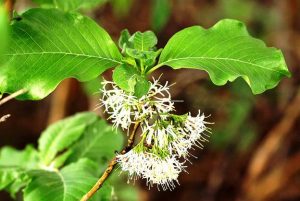
Pavetta eylesii. Photo: Bart Wursten. Source: Flora of Zimbabwe
In six cars we started along the Scenic Drive passing a grove of Olea europea subsp. africana and soon arriving at the entrance to the Pomongwe Cave where a clump of large Heterophyxis natalensis was the central feature, with their distinctive pale grey bark sometimes almost white and flaking, and the strong scent of lavender that exuded from the crushed leaves. In this grove was a rich variety of plants, some familiar to us such as Albizia versicolor, Burkea africana, Apodytes dimidiata, Tarenna neurophylla and a bigger than normal Pittosporum viridiflorum with gum exuding from its bark, while “new” finds for many were Pavetta eylesii with its big leaf and conspicuous black nodules, Bridelia mollis with large soft leaves and Srychnos matopensis, endemic to the Matopos, in yellow fruit and with characteristic tendrils. The varieties numbered well over twenty and the most exciting to Meg was a Turraea obtusifolia growing on a rock with a somewhat triangular shape to the end of the leaf, and it was in fruit. Meg photographed this lovely specimen. We took a quick visit to Pomongwe Cave to see what paintings had survived, unfortunately these are almost invisible after an attempt was made to preserve them, but the vast cathedral cave was most impressive. In this area, two species were ‘new’ to me, Cordia grandicalyx with its large round leaf and Vepris reflexa, having 3-foliolate narrow elliptic leaves with pellucid gland dots, that give out an aromatic scent, lemon, when crushed, this is a member of the RUTACEAE, Citrus family.
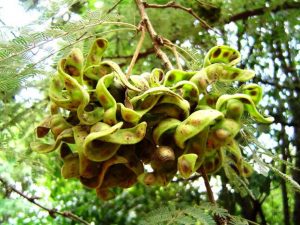
Dichrostachys cinerea. Photo: Bart Wursten. Source: Flora of Zimbabwe
As we continued on our drive my main impression was the abundance of fruit on the trees; Afzelia quanzensis, Pod Mahogany, carrying large green pods, Terminalia sericea with its 2 winged reddish brown fruits in layers through the trees; Dichrostachys cinerea with clusters of twisted green pods; the Mukwa, Pterocarpus angolensis, leafless and distinctive circular pods and Pterocarpus rotundifolius in leaf with flattened winged pods which took on a reddish purple colour at times; Bauhinia thonningii had large flat reddish brown pods and Combretum hereroense, the mouse eared Combretum, was a picture with its copious 4 winged rich brown fruit, and more!
We stopped to examine a very large Crosopteryx febrifuga, one of the ordeal trees, where a concoction of the bark is used in witchcraft. Parts of the tre provide a remedy for fever, hence the specific name. Under the bark we were shown the glistening crystals that blunt cutting tools. Near this was a bigger than usual Turraea nilotica, the small mahogany, with its leaf wrinkled as if a thread had been pulled along its midrib.
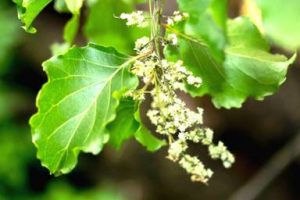
Homelium dentatum. Photo: Geoff Nichols. Source: Flora of Zimbabwe
It was near on mid day when Geoff led a walk into the bush and up a kopje, which opened up a veritable forest of regenerating plants and many well established ones. Some young Pappea capensis with very serrated leaves to stop animals eating them, Schrebera alata, the wing leaved wooden pear, with its distinctive leaves with winged petioles and rachis, Brachyleana rotundata, a compositae, with silver leaves and a very large specimen of Homelium dentatum which appeared to grow leaves at ground level then shoot upwards into a tall straight tree, some 10 – 20m, so that leaves at the top were not easy to see. We were told these trees were favourite nesting places of birds because of height and straight trunk making it difficult for predators to attack. To me the most exciting find was a very large, 15m, Steganotaenia araliacea, the pop gun tree, with a striking grey green bark and feathery leaves high over the canopy. When we returned to the cars its foliage could be clearly seen well above the other greenery, truly giant specimen.
On our way back to the lunch stop we saw Entandrophragma caudatum, wooden banana, on the hillside, and many other species beside the road including Ochna pulchra, with its peeling bark.
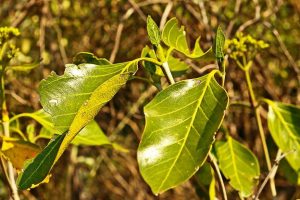
Tarenna zimbabwensis. Photo: Meg Coates Palgrave. Source: Flora of Zimbabwe
At Effifi Picnic Spot, Evelyn, Gwen and Molly, in absentia, provided a delicious cold lunch, cordon bleu standard on a red carpet, or was it a rug, and this was enhanced by bottles of wine, homemade and generously provided by Ken Hartley and liberally dispensed by Alec Dry. It was a feast for the gods, whom I am sure would have taken a post prandil siesta, but we were soon pulled to our feet by Meg, Geoff and Ruth to see Zanthoxylum capenses, with pellucid gland dots round edge of leaf, and large thorny bosses on its trunk. A discussion took place about a Ficus and I think F.salicifolia was decided upon, while the most interesting plant for me was the Tarenna zimbabwensis with its assegai shaped growing point.
As we took off in the cars it was a struggle to keep awake, but the rewarding rusty stems of Acacia rehmanniana with their silky leaves, the abundance of A.fleckii, a grove of flat topped A.tortillis with twisted pods and both straight and hooked thorns could not be missed. Nor could a grove of Terminalia randii, the Lowveld Terminalia with rosettes of leaves, and later on after viewing the Artabotrys brachypetalus with distinctive curling flower stalks, which enable it to climb, we found yet another grove of trees, this time of Pittosporum. In addition to the trees, impala, waterbuck and warthogs, black eagles and a martial eagle kept our attention riveted to the veld. At some stage we looked at some bushman paintings through binoculars, depicting hunters and their aim was at an elephant in rock profile on the opposite side of the road.
What a feast of experiences! I think the official list of trees topped the 100 mark, and for this we must most heartily thank the Bulawayo contingent, who so careful guided us through the grandeur of these Matopos Hills, and let us share with them the joys of nature, especially that of the trees
It was a sparkling day, thank you Geoff, Ruth, Ken and Thora, Nell, Jackie, Betty and Ken.
-Georgie Granelli
And thank you to Georgie for reliving that sparkling day for those of us who were there and for sharing it so graphically for those who were not. Thanks also to Cheryl for a super supper.
Saturday May 3rd : Kloof Farm
On the Saturday we left the Matopas for something completely different. We travelled through Bulawayo meeting a large Bulawayo contingent at the Falls Road garage and then trekking in convoy to the object of our journey, the Kalahari sandveld.
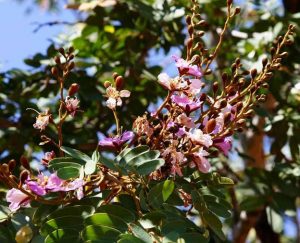
Baikiaea plurijuga. Photo: Bart Wursten. Source: Flora of Zimbabwe
Ken Blake led us onto Kloof Farm, which I believe is part of Helenvale off the Nyamandhlovyu road and in due course we made our first stop. The “just a couple of minutes” developed into a couple of hours of most interesting tree spotting. The key note phrase I believe was “the magic of the Baikaea woodland”. Indeed the memorable feature of the day was the atmosphere of this different woodland The teak trees, Baikiaea plurijuga were the main constituent. Very few were of great size, but what a pleasure to get to know them at eye level I best recall the way in which the leaflets are borne at an angle to the rachis giving a “louvered” effect which is also seen on Brachystegia allenii, on the Zambezi escarpment.
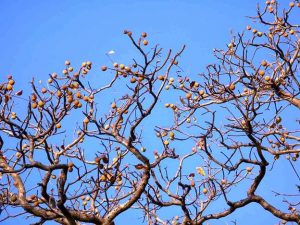
Ricinodendron rautanenii. Photo: Helen Pickering. Source: Flora of Zimbabwe
The primary reason for stopping at that particular point was to be shown a most remarkable tree indeed. This was a Ricinodendron rautanenii, which, despite its superficial resemblance to a baobab, down to the digitate leaves, is actually a member of the EUPHORBIACEAE. This is the local answer to balsa wood, for the wood is as light but strong. We noted both of these features in a felled specimen nearby. The one we stopped to look at had evidently been damaged by fire or lightening for its centre was quite absent resulting in a “room” into which several adults could be accommodated at once, a useful diversion for children. During the course of the morning several of these trees were seen standing igh over the surrounding bush. We were later taken on a detour to see one harbouring a phenomenon at which I continue to marvel At the foot of the tree was a hole, the edges rubbed smooth by the comings and goings of many small animals over the years. Within was a cavity filled up to about ground level with a considerable volume of water. We were told that this water had persisted throughout even the worst of the drought years. The explanation remains a mystery, no one could say whether it was associated with the tree or whether it was a natural spring. We all departed quite baffled!
Reverting to our first stop, a number of unusual observations were made, especially for the Hararians amongst the party. These included Rhus reinuinervis which was small leaved, with rough textured and symmetrical leaves. The flowers were yellow. We saw Vitex mombassae as a small bush which confused most of us by being largely tri-foliate until a single give away leaf was found with four leaflets, lending credence to Meg’s initial diagnosis. Many, mostly small, Ochna pulchra were seen, together with plenty of Euclea divinorum showing the rusty red tinge to the undersides of the leaves the ever present irritation were the Combretums which, without fruit, left us guessing continually between C.opiculatum and C.collinum. Even a C.molle looked similar with small leaves but they at least were velvety soft as one would expect.
This was also Acacia country. New to Hararians were the A.eriocarpa and A.fleckii both withhook thorns and A.erioloba, camel thorn, with straight thorns. Dichrostachys cinerea was abundant with Peltophorum africanum to fool the unwary and there was plenty of A.karroo and A.robusta with the odd A.goetzii.
At our second stop before lunch, apart from Acacia and more Baikiaea, the dwarf Bauhinia was of considerable interest. Previously B.macruntha, this has apparently been sunk into B.petersiana although the form and growth habit and habitat are quite different. A pair of fine Securidaca longepedunculata in fruit were duly admired.
After lunch, again laced with Ken Hartley’s delightful wines in an Acacia grove near Pasipas Hill, some of us scrambled up the hill to the site of the old sandstone quarry from where fine views out over the teak sandveld were obtained. Then, by way of a change, on our way back to Bulawayo the lusts of the birders in our midst were sated by a visit to the Aisleby dams where a large variety of water birds including pelicans were seen.
Our thanks go to Ken Blake and the whole Matabeleland branch for a delightful day and to the Drys for the welcome curry that evening.
-J.P.Haxen
Sunday May 4th : Maleme Dam
Having to vacate the lodges by 1000 hours and return to Harare did not deter us from the prime objective of the weekend. We set out early to descend the slope from Fish Eagle to the dam.
For the most part the vegetation was much the same as we had seen elsewhere in the park, although a large Homalium dentatum made a change from the trailer like specimens we saw before. At the far side of the dam was a Pappea capensis in fruit. This species is related to the litchi, and the look of the flesh of the fruit is certainly similar to the litchi, but there the resemblance ends. The fruit capsule splits to reveal a pink transparent flesh in which is embedded a single seed. The fruit is edible but very sour, and I am sure that the seed, like that of the litchi, must be planted fresh if it is to germinate.
We took the road back to the lodges, and there came across two new sights for the stay. Most spectacular was Apodytes dimidiata in fruit. The fruit was in all stages of development. The ripe ones consisted of a bright red fleshy structure holding the shiny black berry like fruit. Next door was the other new find, Nuxia congesta, with its leaves in whorls, clustered tightly at the ends of branches. The congesta part of the name refers to the flowers which were seen in congested heads at the ends of branches.
Well satisfied botanically we arrived back to be well satisfied gastronomically by Sally who had taken over the task of the massive brunch to allow Meg to pursue her preferred pastime of tree spotting.
-Cheryl Haxen
RUCHOMECHI CAMP, MANA POOLS, APRIL 25th – 28TH 1986
The trip to Mana scheduled for April 11-14th was postponed on account of the unseasonal rain in April. That weekend and the next few days were dry and then the heavens opened and we wondered if we could ever get there. Many phone calls and radio messages later, we did. Garth arranged for us to be taken from Chirundu to Ruchomechi, a distance of about 40km by boat, a lovely way to start the trip. While we were at Mana the weather was kind and we had no rain. However, the area was very wet and it was not possible to take vehicles any distance, even though they did have four wheel drive. So we went as far as we could walk, often fording rivers and trudging through mud and slush, perhaps walking further and for longer than would normally happen, but this was in order to see as many trees and vegetation types as possible.
We were very happy to have Bob Drummond from the Herbarium in our party. The first afternoon was spent wandering along the banks of the Zambezi to one of the mouths of the Ruchomechi delta, while Garth took the opportunity of Bob’s presence to catch up on the shrubs, weeds, herbs of the area, and I might add we were all fascinated by some of these smaller plants. Ocimum canum, wild basil, was the first and Garth was able to pick out plants which, when the leaves were crushed, had a different scent, and speculate on whether these were different species, sub species or vars. Ocimum basilicum is the culinary herb, Sweet Basil, and the flower heads of the wild basil, O.canum, are so similar that we could easily see their relationship. Cassia obtusifolia is a little shrub about knee high with characteristic yellow flowers and was very common; we saw it on all our walks. There was also Cassia mimosoides, a very low growing plant with, as the name suggests, many small leaflets. This has a sessile gland on the petiole. Corchorus tridens, a member of the TILACEAE family had leaves sufficiently Grewia like for us to see the family resemblance. The flowers are yellow but the fruit are elongated capsules looking like pods with 3 diverging horns on the end. There was the white Plubago, Plumbago zeylanica, a straggling small shrub, otherwise very similar to the familiar blue one P.auriculata which comes from the Eastern Cape and Natal and is often grown in gardens and which is reputed to have been one of Rhodes” favourite flowers.
Along that walk the trees were sparse and mostly bush lie but there was the occasional Acacia albida, growing well over our heads, and at this time of the year without the apple ring pods so loved by the elephant. But there were hippos in the water and the bird life was very plentiful which we all enjoyed watching as we did the sunset and the light on the water as we wended our way slowly back to camp. While having a drink in the little bar set high above the water we discovered that it was Maureen’s birthday; this all added to the happiness of the occasion. We had wine with our meal and Kate, the cordon bleu cook, rose to the occasion and produced for a sweet, a cake cut into squares which bore the legend HAPPY BIRTHDAY MAUREEN. Thank you Kate for that and all your meals, they were superb.
Next morning we made an early start; perhaps if we had know what was in store for us we might have stayed in bed. Having driven as far as we could, within sight of camp, we walked through a grove of Acacia albida and forded one of the deltas of the Ruchomechi; we started treeing in earnest. Where do I start? It was one highlight after another. Fortunately Securinega virosa, the white berry bushy, was very common so when we looked around and could not recognize anything else we usually had that to console us. There was Bridelia carthartica, knobby Bridelia, for which we needed binoculars to see the knobs as the tree was so tall. We had been calling Diospyros senensis something else and then realized how wrong we had been when we found it in fruit. This peeling bark Diospyros is a common species in the area and became very familiar to us. They are usually multi stemmed and have enormous spine tipped lateral spurs that some people are misguided enough to call thorns. The sepals on the fruit of this genus are persistent; on this species, D.senensis, they form a cup covering about half the fruit giving it the appearance of a slender acorn.
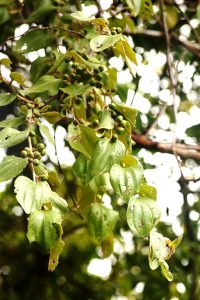
Ziziphus abyssinica. Photo: Bart Wursten. Source: Flora of Zimbabwe
There were sausage trees, Kigelia africana, one of the main constituents of the flood plain, some with sausages and some without, but all with the tell tale strings. Sterculia africana were magnificent with their distinctive white and pink trunks and large fruit most of which were green and still on the trees; but we did find some on the ground with seeds looking like engorged ticks and protected by vicious hairs round the opening. Ziziphus abyssinica, Jujube, in flower was a very exciting find, I don’t think I have seen it before. It differs from our familiar Buffalo thorn, Z.mucronata, by having leaves with veins depressed on the upper surface and much bigger fruit, up to 3cm in diameter.
There were Zanthocercis zambesiaca, Nyala tree and Cordyla africana, wild mango, both of which have compound or pinnate leaves, the leaflets sub-opposite to alternate with a single one at the end, imparipinnate. They are members of the Legume or Pea family and are interesting in that they have a fleshy fruit and not a pod. I became a little confused as to which was which, why I don’t know, as they are very different. If one is lucky enough to reach a leaf and pick it, holding it up to the light and viewing it, preferably through a lens, reveals that the Cordyla leaflets exhibit pellucid dots and streaks and Xanthocercis does not. Other differences are that Cordyla has a dark brown bark and the branches have lenticels. There are more leaflets, 11 – 14 pairs, plus the terminal one, which give the tree a feathery appearance. The flowers of Cordyla are yellow, as those of us who visited Gonaezhou last year will remember, and the fruit are about 8 x 6cm, ripen to yellow and contain several seeds. Xanthocercis is really very different with branchlets hanging down vertically from the branches, almost touching the ground, when there are no browsers; the leaves are a dark shiny green and there are fewer leaflets, only up to 7 pairs, the flowers are white and the fruit smaller, up to 2.5 x 1.7 cm with a single black shiny seed.
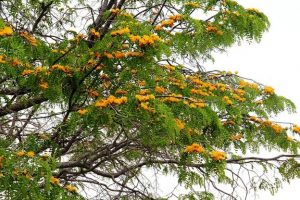
Cordyla africana. Photo: Bart Wursten. Source: Flora of Zimbabwe
There were lots of Strophanthus kombe with the twin fruits, spindle shaped and both together all of 1m long. We saw two Crotons, the fever berry Croton, C.megalobotrys with large triangular shaped leaves, was mostly a bush, no doubt having been frequently hammered by elephant. But we did see some big trees. The other was C.menyhartii, rough leaved Croton which looks rather similar to our familiar Lavendar Croton, C.gratissimus, but has leaves with stellate hairs on the upper surface giving them a very rough feel. Stellate hairs are hairs with several arms radiating horizontally and so looking rather like a star. On both species we looked for and found the 2 little glands at the base of the leaf next to the petiole. We decided that the tangled mass of Acacia was A.ataxacantha despite not being able to find any leaf like stipules. Boscia mossambicensis was in flower with its flowers at the end of the branchlets, making identification unmistakable. It also had smooth glabrous leaves with the midrib impressed on the upper surface but prominent below B.matabelensis, with which this could have been confused is usually much smaller, has rough leaves with the midrib raised on both surfaces and axillary flowers.
And so on, we were due back for a late breakfast, and it was getting later and later. The vehicles were a mere 100m or so away across a bit of river that Garth admitted was a bit muddy but easily crossable That was indeed a very muddy slushy occasion and I think most of us needed a shower and dry clothes before we sat down to our meal which became brunch.
After a rest and some tea we were off again, this time starting off over grass but ending up with the inevitable mud. One of the highlights of that walk was Hippocratea crenata, a scrambling shrub which uses its branches to climb and this one had scrambled fairly high, we had to climb to get a specimen. Hippocratea, a member of the family CELASRACEAE is a genus we do not know very well. They have opposite leaves and often an axillary bud grows out giving a superficial appearance of a compound leaf with a large leaf at the base. H.crenata is a lowveld species with very shiny toothed leaves and small glands on the tips of the teeth particularly those near the base. We looked at A.petersiana that had a long corolla, and we had a discussion on how pollination can take place.
It was late and dark when we returned and no one lingered after supper. On Sunday morning we had an early breakfast. The object of that day’s hike was the mouth of the Nyakasanga River. We again forded the Ruchomechi, or one of its deltas, and to start with repeated the walk we had done the previous day, this enabled us to familiarize ourselves with what we had seen the previous day. This included Strophanthus kombe in large two fruit characteristic of the APOCYNACEAE. Cassine schlecterna is an evergreen species of the alluvium which stands out in the dry season and has opposite leaves with a serrated margin. The lovely Tamarinds, Tamarindus indica were numerous and eventually were found with fruit low enough for us to taste. Garcinia livinstonii with its stiff rigid branches and sticking out leaves in whorls of three which also exhibit a yellow sap like the Granite Garcinia buchannii which we see locally. It was very exciting seeing Garcinia seedlings everywhere, and in the same area the seeds of Colophospermum mopane were germinating.
One of the explanations of the name Colophospermum is “seed that lives in the light” and refers to the fact that the seeds germinate on top of the soil.
Apart from A.albida and A.ataxacantha we onlysaw two other Acacias, A.nigrescens, knob thorn Acacia were distinctive with knobs on their trunks and a single pair of large leaflets on each of the two pinnae and A.robusta subsp. clavigera with apparently many small leaflets and a curved woody pod. This is a straight spined species with globose flowers which are white. A.albida is an unusual Acacia because it has straight spines and flowers I spikes. Usually it is those with prickles which had flowers in spikes.
We walked through some Combretum elaeagnoides and then came to some C.celastrides and at the time I was totally confused as to the differences. How could I have been so stupid – it is quite obvious. I do think that the availability or use of a lens is necessary for distinguishing the leaves. C.celastroides which we have called the jesse bush Combretum has leaves with the lower surface hairy particularly along the veins and in their axils. The fruit are seldom more than 2cm long with wings that become bright red while the body remains greenish yellow; the whole changing to golden brown with a satiny sheen. C.elaeagnoides the large fruited jesse bush Combretum has as the name suggests, larger fruit, 2-3.5 cm long, cream green drying to brown. The leaves are usually glabrous, without hairs, but have silver scales on both surfaces. We also saw C.obovatum, Spiney Combretum, so called because the base of the petioles which remains after the leaf has fallen, can and often does develop into a curved spine. The flowers are insignificant so in order to attract the insects the leaves round the flowers become silvery white and showy and can be mistaken for the flowers. The leaves are very obovate, upside down egg, and the fruit is 5 winged. Also with 5 winged pods, all of which had fallen when we were there, was C.mossambicense, shaving brush Combretum which has a rather Albizia like flower. This also has persistent petioles with which it climbs or clings and a purplish tinge to the branchlets and twigs which distinguish that from Combretum microphyllum, the flaming bush Combretum, which is so spectacular in flower. The most exciting of the climbers however, was Combretum kirkii which climbed to 15m and has a stem of 15cm in diameter with knobs all the way up this we found in fruit which are almost as large as those of C.zeyheri, large fruited Combretum. C.kirkii was first collected by Kirk from Tete in 1860 and is apparently cnfined to the Zambezi Valley and its tributaries. The other tremendous excitement of the walk was finding the Wild Citrus, Citropsis daweana, a small spiny tree bearing soft velvety leaves which have a strong Citrus smell when crushed. It was bearing neither flowers nor fruits but apparently the fruit is like a small lemon about 1-1.4 cm in diameter.
By then we were finding the going hot and tiring and perhaps our eyes were not as keen as they had been earlier, but eventually we reached the Nyakusanga and some of us lay down in the water clothes and all, it was so shallow that in order to get properly wet one had to turn over, so there was no chance of a crocodile sneaking up on us. We paddled through the cool shallow water to the mouth where Kate had delicious hot homemade pies and ice cold beer waiting for us.
After we had rested we all decided to take to the canoes so the Banana boat returned alone with its crew and our empties. Ann wrote that having got over her initial timidity that afternoon floating downstream remains one of the treasures in memory. I am sure we all agree. The bank with the White fronted bee eaters, the water birds, the trees were starting to recognize from a distance and the silence and peace and the hippo, sometimes closer than we cared for just to remind us that we were on the Zambezi.
That evening after dinner Garth showed us slides of both some of the things we had seen, and some of those we had not, particularly the animals.
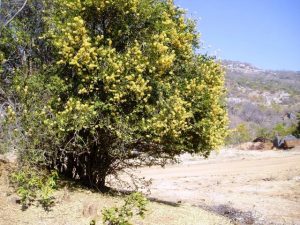
Cadaba kirkii. Photo: Mark Hyde. Source: Flora of Zimbabwe
However, on the last morning we were to have a final fling, or should I say last slip and slosh. We went to a spot where the soils were sodic and the Hyphaena benguellensis, Northern Ilala Palms, flourished, and along the edge grew enormous trees, so large at times that they formed a giant canopy. These included Khaya nyassica and Tamarindus. We saw a Cadaba kirkii on an ant hill in full flower, this is common in the Valley. There was Salvadora persica, Mustard Tree, whose leaves sometimes have gland dots and the plants are reputed to emit an unpleasant odour. The fruit is 5-10mm in diameter, turns pink when ripe, has a slightly pungent sweet taste and contains a single seed rich in oil, and in particular benzyl mustard oil which may, with the leaves, have provided the mustard of the Bible. “Persica” means from Persia.
And the tree I left out? Pronounced either CARD-EE-O-JEAN, or CARD-EE-OGOG-NEE or CARD-EE-O-NYNE is fortunately called Maclura. And then it was time to pack, breakfast, board the boats and be on our way. Thank you to Garth and your team and also to those who came on the trip; that companionship, that sharing, it was all very special and very magic.
-Meg Coates Palgrave
MWENGE DAM ; 18TH MAY 1986
Unfortunately, this month’s outing clashed with the History Society’s trip to Lake MacIlwaine and the Tree Society Arboretum, so our numbers were somewhat depleted. Nevertheless, we would like to thank those members who went to represent the Tree Society at MacIlwaine and particularly Dick Petheram who had prepared a talk on the history of the arboretum, and Phil Haxen who helped lead a party as well.
Mwenge Dam is situated on the Wengi River almost due north of Glendale. The Wengi drains the dyke before flowing into the Mazowe. The drive out therefore took us past the Mazower Dam Kiosk where we all bailed out for oranges. The kiosk has a few large Ficus thonningii on the dam wall side, with a F.ingens on the opposite side. Further along and down at the water’s edge is a magnificent F.sur, in full fruit. But there on the ground in front of the kiosk was a carpet of fig leaves belonging to none of these trees, they were from F.cordata subsp. salicifolia from the large inaccessible tree that grows above and behind the kiosk. The devil’s advocates were able to find very similar leaves on the F.ingens, but the diagnosis has been confirmed by Bob. The petioles of F.cordata are less rigid and so the leaves hang in a more relaxed manner than the stiff, formal leaves of F.ingens. The leaves of F.ingens are generally more cordate and spear shaped by comparison with the oblong leaves of F.cordata. I still find the basal veins distinctive, using Berg’s feature that in F.cordata these curve to run parallel with the margin whereas in F.ingens they are straight, or branched, but not as parallel to the margin.
The Mwengi car park is in a Combretum grove and here we destroyed one of our favourite Linus blankets; these trees were obviously C.collinum, their fruits were too small for C.zeyheri and were a deep maroon colour. The leaves all drooped like C.collinum often does and the under surfaces were characteristically pale BUT the leaves were all too often in whorles of three and this feature we have often used as a feature that distinguishes C.zeyheri from the variable C.collinum. So in future we will have to be more careful and not be so dogmatic with the trees that provide fewer clues than these.
I don’t often find spillways aesthetically attractive, but Mwengi certainly is. Set into the wall in a sweeping concave crescent the water spills over the lip and curtains down away from the wall leaving a space between the sheet of water and the wall itself. Walking along this narrow corridor of spray and filtered sunlight is a breathtaking experience. Besides your breath it also takes away your dry state so I spent much of the sunny morning walk drying out again. From the wall we progressed south to a most interesting patch of woodland. I was constantly left behind and even then ended up glossing over so much.
Having passed a few large Parinari, a Securidaca hanging in green fruit and a thicket of Dichrostachys we came across a large female Antidesma venasum covered in red tassel berries. I have always mistakenly associated this species with riverine vegetation, but it is apparently not out of place in woodland or even wooded grassland, according to CP. Beneath these trees I collected a member of the Rubiaceae with smooth leaves and a very long tapering interpetiolar stipule. It took a reminder to prompt Vangueria randii. I had forgotten the conflict between V.randii and V.apiculata, despite once having spent a fruitless few hours at Vumba attempting to sort it out. As a result I never collected a specimen or looked out for evidence of the long calyx lobes characteristic of V.apiculata. CP says of V.randii “no where common” and if this is true we were seeing V.apiculatum everywhere. It must have been one of the more common shrubs around.
The discussion on Mwenge Dam will continue next month, when we have more space.
-Kim ST.J.Damstra
KIM DAMSTRA CHAIRMAN


